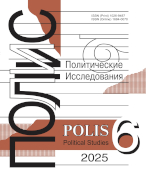Международные нормы в свете технологических изменений:
вызовы конструктивистской теории в сфере контроля над вооружениями
Истомин И. А.,
Кандидат политических наук, МГИМО МИД России, Москва, Россия, i.istomin@inno.mgimo.ru
elibrary_id: 333124 | ORCID: 0000-0002-8334-6343 | RESEARCHER_ID: A-8494-2017
Виньо А. ,
Доктор философии (PhD), МГИМО МИД России, Москва, Россия; Редингский университет, Рединг, Великобритания, vigneau.a@my.mgimo.ru
elibrary_id: 1090824 |
Дата поступления статьи: 2023.02.06. Принята к печати: 2023.05.10

DOI: 10.17976/jpps/2023.04.02
EDN: UAPADM
Истомин И. А., Виньо А. Международные нормы в свете технологических изменений: вызовы конструктивистской теории в сфере контроля над вооружениями. – Полис. Политические исследования. 2023. № 4. С. 7-22. https://doi.org/10.17976/jpps/2023.04.02. EDN: UAPADM
Авторы выражают глубокую признательность Уильяму К. Уолфорту, Ирине Болговой, Александру Чехову, Ивану Фомину, Кристоферу Кортену, Николаю Силаеву, Максиму Сучкову и Андрею Сушенцову за комментарии, предложения и критику.
Возникновение, распространение и интернационализация международных норм сталкиваются с недооцененными вызовами в сфере контроля над вооружениями, который ограничивает разработку и применение средств организованного насилия. Настоящая статья фокусируется на значении неопределенности, порождаемой технологическими изменениями, осложняющей становление и распространение норм в данной области. Динамичный характер технологических изменений порождает ожидания революционной новизны и выступает источником радикальной неопределенности, подрывающих действие ряда механизмов и процессов, которым конструктивистская теория приписывает центральную роль в укреплении международного регулирования (в том числе поиск нормативных кросс-аналогий, стратегический торг, эволюция морального сознания). Изучение показательного случая режима запрещения биологического оружия подтверждает, что становление и распространение международных норм сталкиваются со значительными трудностями в сфере контроля над вооружениями и что нормы, ограничивающие средства организованного насилия, остаются сильно уязвимыми даже после первичной институционализации ввиду неопределенности, порождаемой технологическими изменениями.
Список литературы
Алексеева, Т.А. 2022. Агент-структурные отношения: методология конструктивизма. Полис. Политические исследования. № 4. P. 77-93. https://doi.org/10.17976/jpps/2022.04.07. EDN: IZCMJV.
Арбатов А.Г. 2019. Диалектика Судного дня: гонка вооружений и их ограничения. Полис. Политические исследования. № 3. С. 27-48. https://doi.org/10.17976/jpps/2019.03.03. EDN: OQBVVH.
Acharya, A. (2004). How ideas spread: whose norms matter? Norm localization and institutional change in Asian regionalism. International Organization, 58(2), 239-75. https://doi.org/10.1017/S0020818304582024
Ali, R. (2009). Technological neutrality. Lex Electronica, 14(1). https://www.lex-electronica.org/files/sites/103/14-2_ali.pdf
Arbatov, A. (2019). Mad momentum redux? The rise and fall of nuclear arms control. Survival, 61(3), 7-38. http://dx.doi.org/10.1080/00396338.2019.1614785
Beard, J. M. (2007). The shortcomings of indeterminacy in arms control regimes: the case of the biological weapons convention. American Journal of International Law, 101(2), 271-321. https://doi.org/10.1080/00396338.2019.1614785
Brooks, L.F. (2020). The end of arms control? Daedalus, 149(2), 84-100. http://dx.doi.org/10.1162/daed_a_01791
Bull, H. (1977). The anarchical society: a study of order in world politics. London: Macmillan.
Buzan, B. (2004). From international to world society? English school theory and the social structure of globalisation. Cambridge: Cambridge University Press.
Carpenter, R.C. (2011). Vetting the advocacy agenda: network centrality and the paradox of weapons norms. International Organization, 65(1), 69-102. https://doi.org/10.1017/S0020818310000329
Carpenter, R.C. (2007). Setting the advocacy agenda: theorizing issue emergence and nonemergence in transnational advocacy networks. International Studies Quarterly, 51(1), 99-120. https://doi.org/10.1111/J.1468-2478.2007.00441.X
Checkel, JT. (2017). Socialization and violence: Introduction and framework. Journal of Peace Research, 54(5), 592-605. https://doi.org/10.1177/0022343317721813
Cooper, N., & Mutimer, D. (2011). Arms control for the 21st century: controlling the means of violence. Contemporary Security Policy, 32(1), 3-19. http://dx.doi.org/10.1080/13523260.2011.556820
Dellapenna, J.W. (1999). Law in a shrinking world: The interaction of science and technology with international law. Kentucky Law Journal, 88(4), 809-83. https://conservancy.umn.edu/bitstream/handle/11299/156342/ahc_asset_365988.pdf?sequence=1
Epstein, C. (2012). Who speaks? Discourse, the subject and the study of identity in international politics, European Journal of International Relations, 17(2) (2011), 327-50. http://dx.doi.org/10.1177/1354066109350055
Finnemore, M., & Sikkink, K. (1998). International norm dynamics and political change. International Organization, 52(4), 887-917. https://doi.org/10.1162/002081898550789
Haas, P.M. (1989). Do regimes matter? Epistemic communities and Mediterranean pollution control. International organization, 43(3), 377-403. https://doi.org/10.1017/S0020818300032975
Hanson, M. (2018). Normalizing zero nuclear weapons: The humanitarian road to the Prohibition Treaty. Contemporary Security Policy, 39(3), 464-86. https://doi.org/10.1080/13523260.2017.1421344
Hatch, B.B. (2018). Defining a class of cyber weapons as WMD: an examination of the merits. Journal of Strategic Security, 11(1), 43-61. https://doi.org/10.1080/13523260.2017.1421344
Holmes, E.C., Goldstein, S.A., Rasmussen, A.L., Robertson, D.L., Crits-Christoph, A., Wertheim, J.O., & Rambaut, A. (2021). The origins of SARS-CoV-2: a critical review. Cell, 184(19), 4848-4856. https://doi.org/10.1016/j.cell.2021.08.017
Jervis, R. (1978). Cooperation under the security dilemma. World Politics, 30(2), 167-214. https://doi.org/10.2307/2009958
Kalpokienė, J., & Kalpokas, I. (2020). Contemplating a cyber weapons convention: an exploration of good practice and necessary preconditions. Baltic Journal of Law & Politics, 13(1), 51-80. http://dx.doi.org/10.2478/bjlp-2020-0003
Katzenstein, P.J. (Ed.) (1996). The culture of national security: norms and identity in world politics. New York, NY: Columbia University Press.
Keck, M.E., & Sikkink K. (1998). Activists beyond borders: advocacy networks in international politics. Ithaca: Cornell University Press.
Koops, B.-J. (2006). Should ICT regulation be technology-neutral? In B.-J. Koops, M. Lips, C. Prins, & M. Schellekens (Ed.), Starting Points for ICT Regulation. Deconstructing Prevalent Policy One-Liners, IT & Law Series (pp. 77-108). Hague: T.M.C. Asser Press.
Kutz, C. (2014). How norms die: Torture and assassination in American security policy. Ethics & International Affairs, 28(4), 425-449. https://doi.org/10.1017/S0892679414000598
Lentzos, F. (2019). Compliance and enforcement of the biological weapons regime. United Nations Institute for Disarmament Research. https://www.unidir.org/sites/default/files/2019-12/UNIDIR%20WMD%20CE%20-%20Paper%204%20v2.pdf
Liivoja, R. (2015). Technological change and the evolution of the law of war. International Review of the Red Cross, 97(900), 1157-77. https://doi.org/10.1017/S1816383116000424
Maas, M.M. (2019). How viable is international arms control for military artificial intelligence? Three lessons from nuclear weapons. Contemporary Security Policy, 40(3), 285-311. https://doi.org/10.1080/13523260.2019.1576464
Mazanec, B.M. (2016). Constraining norms for cyber warfare are unlikely. Georgetown Journal of International Affairs, 17(3), 100-109. http://dx.doi.org/10.1353/gia.2016.0040
McCarthy, D.R. (Ed.). (2017). Technology and world politics: an introduction. London, Abington: Routledge.
McKeown, R. (2009). Norm regress: US revisionism and the slow death of the torture norm. International Relations, 23(1), 5-25. https://doi.org/10.1177/0047117808100607
Moses, L.B. (2007). Recurring dilemmas: The law's race to keep up with technological change. University of Illinois Journal of Law, Technology & Policy, 2, 239-86. https://dx.doi.org/10.2139/ssrn.979861
Moses, L.B. (2013). How to think about law, regulation and technology: Problems with ‘technology’ as a regulatory target. Law, Innovation and Technology, 5(1), 1-20. https://doi.org/10.5235/17579961.5.1.1
Nadelmann, E.A. (1990). Global prohibition regimes: The evolution of norms in international society. International Organization, 44(4), 479-526. https://doi.org/10.1017/S0020818300035384
Niemann, H., & Schillinger, H. (2017). Contestation ‘all the way down’? The grammar of contestation in norm research. Review of International Studies, 43(1), 29-49. https://doi.org/10.1017/S0260210516000188
Panke, D., & Petersohn, U. (2012). Why international norms disappear sometimes. European Journal of International Relations, 18(4), 719-742. https://doi.org/10.1177/1354066111407690
Panofsky, W.K. (1998). Dismantling the concept of 'weapons of mass destruction'. Arms Control Today, 28, 3-8.
Pastel, R.H. (2004). Psychological effects of 'weapons of mass disruption'. Psychiatric Annals, 34(9), 679-686. https://doi.org/10.3928/0048-5713-20040901-13
Payne, K. (2018). Artificial intelligence: a revolution in strategic affairs? Survival, 60(5), 7-32. https://doi.org/10.1080/00396338.2018.1518374
Picker, C.B. (2001). A view from 40,000 feet: international law and the invisible hand of technology. Cardozo Law Review, 23, 149-219.
Price, R. (2019). Syria and the chemical weapons taboo. Journal of Global Security Studies, 4(1), 37-52. https://doi.org/10.1093/jogss/ogy040
Price, R. (1995). A genealogy of the chemical weapons taboo. International Organization, 49(1), 73-103. https://doi.org/10.1017/S0020818300001582
Price, R., & Tannenwald, N. (1996). Norms and deterrence: the nuclear and chemical weapons taboo. In P.J. Katzenstein (Ed.), The Culture of National Security: Norms and Identity in World Politics (pp. 114-152). New York, NY: Columbia University Press.
Rathbun, B.C. (2007). Uncertain about uncertainty: understanding the multiple meanings of a crucial concept in international relations theory. International Studies Quarterly, 51(3), 533-557. https://doi.org/10.1111/j.1468-2478.2007.00463.x
Reed, C. (2007). Taking sides on technology neutrality. SCRIPTed, 4(3), 263-84. https://doi.org/10.2966/scrip.040307.263
Rid, T., & McBurney, P. (2012). Cyber-weapons. The RUSI Journal, 157(1), 6-13. https://doi.org/10.1080/03071847.2012.664354
Risse, T., & Sikkink K. (1999). The socialization of international human rights norms into domestic practice: introduction. In Th. Risse, S.C. Ropp, & K. Sikkink (Ed.), The Power of Human Rights: International Norms and Domestic Change (pp. 1-38). Cambridge: Cambridge University Press.
Rosert, E. (2019). Norm emergence as agenda diffusion: Failure and success in the regulation of cluster munitions. European Journal of International Relations, 25(4), 1103-31. https://doi.org/10.1177/1354066119842644
Rumer, E. (2018). A farewell to arms… control. Carnegie Endowment for International Peace, https://carnegieendowment.org/files/Arms_Control-Rumer.pdf
Schelling, T.C., & Halperin, M. (1961) Strategy and arms control. New York, NY: The Twentieth Century Fund.
Schneiker, A. (2021). Norm sabotage: Conceptual reflection on a phenomenon that challenges well-established norms. International Studies Perspectives, 22(1), 106-23. https://doi.org/10.1093/isp/ekaa003
Shane, S. (1995). Uncertainty avoidance and the preference for innovation championing roles. Journal of International Business Studies, 26(1), 47-68. https://doi.org/10.1057/palgrave.jibs.8490165
Stimmer, A. (2019). Beyond internalization: Alternate endings of the norm life cycle. International Studies Quarterly, 63(2), 270-80. https://doi.org/10.1093/isq/sqz001
Sunstein, C.R. (1996). Social norms and social roles. Columbia Law Review, (96), 904-968. https://papers.ssrn.com/sol3/papers.cfm?abstract_id=10001
Wagner, M. (2012). Beyond the drone debate: autonomy in tomorrow’s battlespace. Proceedings of the ASIL Annual Meeting, 106, 80-4. https://doi.org/10.1057/s41267-019-00242-8
Watts, L.L., Steele, L.M., & Den Hartog, D.N. (2020). Uncertainty avoidance moderates the relationship between transformational leadership and innovation: a meta-analysis. Journal of International Business Studies, 51(1), 138-145. https://doi.org/10.1057/s41267-019-00242-8
Wendt, A. (1999). Social theory of international politics. Cambridge: Cambridge University Press.
Winston, C. (2018). Norm structure, diffusion, and evolution: a conceptual approach. European Journal of International Relations, 24(3), 638-661. https://doi.org/10.1177/1354066117720794
Wolff, J., & Zimmermann, L. (2016). Between banyans and battle scenes: liberal norms, contestation, and the limits of critique. Review of International Studies, 42(3), 513-534. https://doi.org/10.1017/S0260210515000534
Zwingel, S. (2012). How do norms travel? Theorizing international women’s rights in transnational perspective. International Studies Quarterly, 56, 115-129. https://doi.org/10.1111/j.1468-2478.2011.00701.x
Возможно, Вас заинтересуют:
Севостьянов П. И., Мизин В. И.,
Контроль над ядерным оружием, климатические изменения и киберугрозы: три проблемы или одна?. – Полис. Политические исследования. 2024. №3
Арбатов А. Г.,
Десять апорий нашего времени. Теория и практика ядерного сдерживания. – Полис. Политические исследования. 2021. №4
Арбатов А. Г.,
Китай и ограничение вооружений: не утопия, а возможность. – Полис. Политические исследования. 2020. №4
Ознобищев С. К.,
Политика и контроль над вооружениями. – Полис. Политические исследования. 2021. №6
Арбатов А. Г.,
Ядерный бумеранг. Нет ни вечных союзников, ни постоянных врагов, но вечно и постоянно только ядерное оружие. – Полис. Политические исследования. 2025. №5




.jpg)






 версия для печати
версия для печати
.jpg)
.jpg)